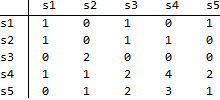Note that these matrices represent two different weighted directed graphs with 5 vertices. Elements of these two matrices are assigned to one of the threefive states s1=[0, 0.5], s2=(0.5, 1], and s3=(1, 1.5] etc.
r1T1=BoolEval[0<= matT1<=0.5]/.{1->s1};
r2T1=BoolEval[0.5<matT1<= 1]/.{1-> s2};
r3T1=BoolEval[1<matT1<=1.5]/.{1 -> s3};
r4T1=BoolEval[1.5<matT1<=2]/.{1 -> s4};
r5T1=BoolEval[2<matT1<=2.5]/.{1 -> s5};
matT1S = r1T1 + r2T1 + r3T1 + r4T1 + r5T1 // MatrixForm
r1T2=BoolEval[0<=matT2<=0.5]/.{1 -> s1};
r2T2=BoolEval[0.5<matT2<=1]/.{1 -> s2};
r3T2=BoolEval[1<matT2<=1.5]/.{1 -> s3};
r4T2=BoolEval[1.5<matT2<=2]/.{1 -> s4};
r5T2=BoolEval[2<matT2<=2.5]/.{1 -> s5};
matT2S = r1T2 + r2T2 + r3T2 + r4T2 + r5T2 // MatrixForm
Clear[n, states, map];
n = Length[matT2S];
states = {s1, s2, s3, s4, s5};
map = {};
Do[
If[matT1S[[i, j]] == states[[1]] &&
matT2S[[i, j]] == states[[2]],
AppendTo[map, {i, j}]
], {i, n}, {j, n}
] (* states[[i]] index should be changed for each transition type. This code generates the number of transition (3) from `s1` to `s2` only.*)
Length[map] (* gives 30 *)
Rows are associated with time t and columns with t+1. This map illustrates that, out of 63 links in state s1 at time t, 2 remain1 remains in s1 at t+1, and 3 move1 moves to s2s3 at t+1 and 1 moves to s3s5 at t+1. Other numbers in the map should be read likewise. Using this map,
traMap =traMap={
{21,30,1,0,1},
{31,50,1,1,0},
{0,2,0,0,0},
{1,1,2,4,2},
{0,1,2,3,1}
};
transMatrix=
DiagonalMatrix[1/Total[traMap,
{2}]].traMap
transMatrix = {
{1/3, 0, 1/3, {2/60, 3 1/63},
{1/6}3,
0, 1/3, 1/3, 0 },
{3/100, 5/10, 2/10} 1,
0, 0, 0 },
{21/910, 1/10, 41/95, 32/95, 1/5},
{0, 1/7, 2/7, 3/7, 1/7}
};
which is:
and
This limiting distribution translates the current vector (63, 3, 2, 10, 97) to (0.2917, 0.4926, 0.22)*(6, 100.23, 90.12) = *(73,25 3, 12.252, 5.510, 7). This means that states s1 and s2 host more links while state s3 looses its members.
My question: Although I found out the change shown as (7,25, 12.25, 5.5)transition, I do not know which linkages are in each state in the final period t+100. I know that 7.25 will be in state s1 after 100 repetition of transition but which linkages are they? Basically, I like to know the specific linkages associated withthe new distribution (70.2517, 120.2526, 50.522, 0.23, 0.12)*(3, 3, 2, 10, 7).





